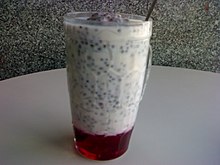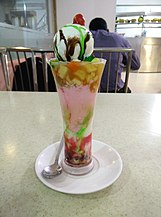| Revision as of 18:46, 13 February 2019 editWikaviani (talk | contribs)Extended confirmed users, Pending changes reviewers, Rollbackers14,595 edits →History: Added sourceTag: 2017 wikitext editor← Previous edit | Revision as of 18:49, 13 February 2019 edit undo175.137.72.188 (talk) unreliable and irrelevant source/ persian glog post on persian faloodeh removedTags: references removed Visual editNext edit → | ||
| Line 26: | Line 26: | ||
| | image4 = Phaluda.JPG|caption4=Falooda from ]. | | image4 = Phaluda.JPG|caption4=Falooda from ]. | ||
| }} | }} | ||
| Falooda was developed by the ] and spread with its many conquests. Muslim rulers who succeeded from the ] patronized the dessert with their own adaptations, specifically in ] and the ] areas of present-day India.<ref name=":0">{{Cite web|url=http://www.eatingindia.net/blog/the-royal-falooda/|title=The Royal Falooda |last=|first=|date=|website=Eating India|access-date=4 April 2016}}</ref> This dessert is now a major part of Pakistani culture, specially served on Islamic holidays and other occasions. It is also a well known part of ] modern culture. | |||
| ==Metaphorical references== | ==Metaphorical references== | ||
Revision as of 18:49, 13 February 2019
For the similarly named Persian dessert, see Faloodeh. Indian dessert Falooda with kulfi, rose syrup, and basil seeds Falooda with kulfi, rose syrup, and basil seeds | |
| Course | Beverage |
|---|---|
| Region or state | Indian subcontinent |
| Main ingredients | Milk, rose syrup, vermicelli, sweet basil |
Falooda (also Faluda, Faloodah) is a cold dessert with origins in the Indian subcontinent. Traditionally it is made from mixing rose syrup, vermicelli, sweet basil (sabza/takmaria) seeds with milk, often served with ice cream. The vermicelli used for preparing falooda is made from wheat, arrowroot, cornstarch, or sago.
Falooda is not only a drink but can be a meal in itself. Some ingredients like soaked basil seeds have a cooling effect on the body. Falooda is also often served with various nuts.
History
 A version of falooda with fruits, nuts, and an ice cream topping.
A version of falooda with fruits, nuts, and an ice cream topping. Bawarchi special Faluda.
Bawarchi special Faluda. Falooda from a shop at Juhu Beach, Mumbai, India.
Falooda from a shop at Juhu Beach, Mumbai, India. Falooda from Myanmar.
Falooda from Myanmar.
Falooda was developed by the Mughal Empire and spread with its many conquests. Muslim rulers who succeeded from the Mughals patronized the dessert with their own adaptations, specifically in Hyderabad Deccan and the Carnatic areas of present-day India. This dessert is now a major part of Pakistani culture, specially served on Islamic holidays and other occasions. It is also a well known part of Sri Lankan modern culture.
Metaphorical references
In idiomatic Hindustani, falooda is sometimes used as a reference to something that has been shredded, which is an allusion to the vermicelli noodles. For example, someone who falls into disrepute might say that his or her izzat (honour) has been turned to falooda (इज़्ज़त का फ़लूदा, عزت کا فالودہ, izzat ka falooda), which is roughly equivalent to saying "my reputation is shot."
Variants
- Several are made without noodles and blended with fruit.
- In Sri Lanka, the drink is known as Faluda, and is very popular among locals. The drink typically does not contain many spices or nuts, making the drink much more pleasurable.
- Some Indian versions consist of kulfi, translucent wheat-starch noodles, and flavoured syrup.
- In Bangladesh, a common variant of Falooda in the south coast of the country is made with Ketaki (pandan) extract, pistachios, sago pearls, creamed coconut and mango as well as milk and vermicelli, and may even include strong black tea to make quite a distinct flavour.
- Malaysia and Singapore have a similar drink called bandung.
- Falooda is very similar to the Thai drink nam maenglak (น้ำแมงลัก, "lemon basil drink"), which is made from different ingredients, such as pre-soaked lemon basil seeds, shredded jelly, tapioca pearls, and Job's Tears mixed with sugar, water, and rose water.
- The Iraqi Kurds also have their own version; but made with thicker vermicelli.
- A similar modern East Asian drink is bubble tea.
- A famous type of falooda, called "Andrea", involves mixing various rose syrups with creamy milk and premature tapioca pearls.
- Rabri faluda
- The Mauritian version is called alouda, which is a variation of the word falooda, and the beverage is almost identical in ingredients and flavour.
- South Africa also has a variant known by the same name, and is often served as a milkshake to be consumed with or after a meal. There was a famous restaurant in Durban called Moola's who made it and called it Bombay Crush.
See also
References
- ^ "The Royal Falooda". Eating India. Retrieved 4 April 2016.
- "Falooda Recipe". Retrieved 3 January 2017.
- "Falooda". ifood.tv. Archived from the original on 25 January 2015. Retrieved 26 January 2015.
{{cite web}}: Unknown parameter|deadurl=ignored (|url-status=suggested) (help) - "Falooda Sev Recipe". Retrieved 3 January 2017.
- Tarla Dalal (2010). Low Calorie Sweets. Sanjay & Company. p. 35. ISBN 978-8-189491-34-5. Retrieved 13 July 2018.
- Ranveer Brar. "Sweet Falooda". livingfoodz.com. Retrieved 22 August 2018.
- India today, Volume 24, Thomson Living Media India Ltd., 1999,
... Magar this time to izzat ka falooda ban jayega (my reputation will be shot) ...
- Rabdi faluda
- viii. Cape Malay Food Recipes « Cape Malays…
External links
| Burmese cuisine | |
|---|---|
| Salads | |
| Rice dishes | |
| Noodle dishes | |
| Other dishes | |
| Snacks |
|
| Drinks and beverages | |
| Seasonings and ingredients | |
| Miscellaneous | |
| Dishes |
| ||||||
|---|---|---|---|---|---|---|---|
| Side dishes |
| ||||||
| Snacks | |||||||
| Beverages | |||||||
| Sweets & desserts |
| ||||||
| Condiments | |||||||
| Ingredients | |||||||